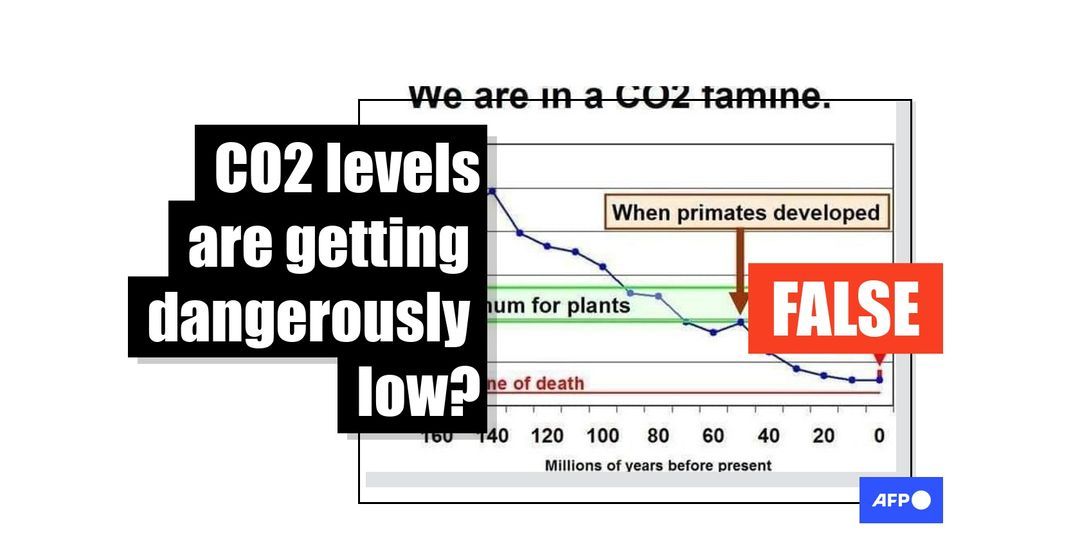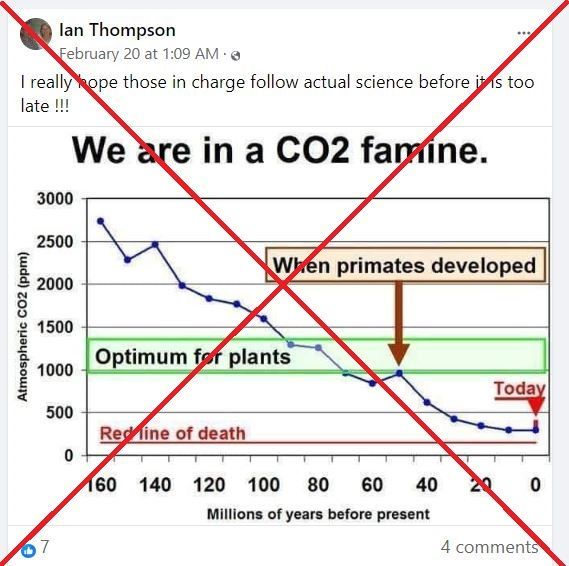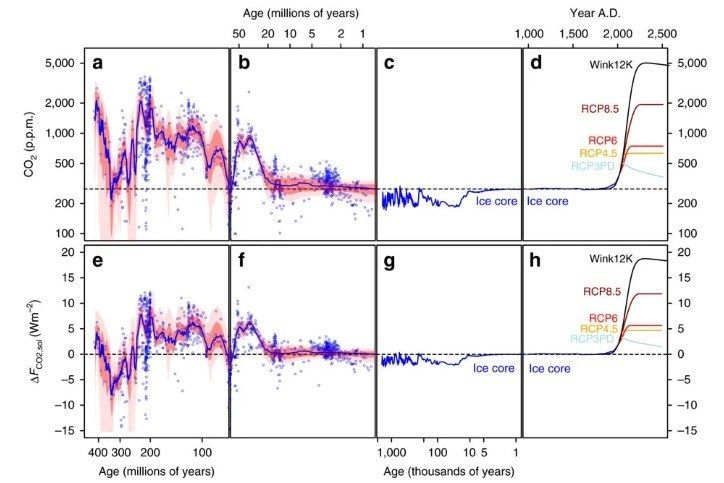
The world is not facing a deadly carbon dioxide (CO2) “famine”, multiple scientists told AFP, contrary to claims repeatedly shared in social media posts that deny global warming is real. They said CO2 levels have been rising at an unprecedented rate since the pre-industrial era, heating the planet with disastrous effects.
“We are in a CO2 famine,” reads the title of a chart shared on Facebook on February 20, 2024. It appears to show decreasing levels of atmospheric CO2 — measured in parts per million (ppm) — throughout the planet’s history.
Levels purportedly decreased from over 2,500 ppm 160 million years ago to under 500 ppm during the present time. The chart indicates current levels are nearing a “red line of death” and way below what is “optimum for plants”.
“I really hope those in charge follow actual science before it is too late,” reads the caption alongside the chart. It was also shared by social media users in Australia and Sweden.

Similar posts from New Zealand and France featured a 37-second video clip of an interview with William Happer, a professor of physics from Princeton University, aired by Sky News Australia in September 2023.
Happer, formerly a science advisor to former US president Donald Trump, said in the interview: “More CO2 is good for the world. It’s not bad for the world. And so it’s absurd to be trying to reduce CO2.”
“We are in a CO2 famine now, compared to what is normal for plants. And just about any plant, if you give it more CO2 and a lot more, it will do better,” he added.
In response to an enquiry from AFP, Professor Happer said he stood by his comments.
“The clearest evidence that Earth is in a CO2 famine, compared to what most plants would prefer, is that growers of flowers, fruits and vegetables continue to pay the substantial costs of tripling or quadrupling the concentrations of CO2 in their greenhouses,” he said.
Multiple climate scientists, however, told AFP the world faces no risk of a “CO2 famine” and the opposite is happening. They said CO2 levels — mostly from human burning of fossil fuels — have been increasing at an unprecedented rate since pre-industrial times.
Scientific consensus
“We are far away from any CO2 famine,” Howard Diamond, a senior climate scientist at the US National Oceanic and Atmospheric Administration (NOAA) told AFP on February 13, 2024 (archived link).
Pelle Boberg, climate analyst at the Swedish Environmental Protection Agency, separately said on February 15: “The problem is the opposite, that the amount of carbon dioxide in the atmosphere is growing fast” (archived link).
“Carbon dioxide levels have varied greatly over time, and life on Earth has adapted to it,” Boberg explained. But the speed at which CO2 is currently increasing is “happening so fast that it is becoming more and more difficult for ecosystems to keep up with adapting to it”.
According to a report issued by the UN Intergovernmental Panel on Climate Change (IPCC) in 2021: “The evidence is clear that carbon dioxide (CO2) is the main driver of climate change, even as other greenhouse gases and air pollutants also affect the climate” (archived link).
Limiting global warming is crucial to averting a long-term planetary climate disaster, the report’s authors wrote.
“For 1.5C of global warming, there will be increasing heat waves, longer warm seasons and shorter cold seasons,” they said. “At 2C of global warming, heat extremes would more often reach critical tolerance thresholds for agriculture and health.”
The IPCC report reflects a global scientific consensus on the issue.
‘Preposterous’ chart details
The chart repeatedly shared online was also not accurate, experts said.
Diamond from NOAA said the chart showing the planet hovering near a “line of death” was “pretty preposterous and not in keeping with the science or any of the data we have”.
He explained that ice core data — samples that enable scientists to estimate what climate from the past — found a cycle of between about 180 to 290 ppm of CO2 over the past 800,000 years.
That level was less than the current CO2 concentration at about 420 ppm but “living organisms did just fine” Diamond said.
He also pointed to a graph in a 2017 paper published in Nature Communications, showing CO2 levels over the past 420 million years and setting this in the context of projected future change (archived version).
The graph included estimates of CO2 levels over the next several hundreds of years, based on different future emission scenarios by the IPCC, showing levels will reach highs not seen in millions of years.
The paper said unabated fossil fuel use leading to continued rise in CO2 could lead to a scenario that was likely “without geological precedent in the last half a billion years”.
Below is a screenshot of the graph found in the paper:

Plant life
Claims that increased CO2 levels are beneficial for plants also omit important context.
Plants use sunlight to convert CO2 into a source of energy in a process called photosynthesis. Experts said increased CO2 levels could to some extent, therefore, stimulate plant growth.
But Antoine Martin, a senior scientist from the Institute for Plant Sciences of Montpellier told AFP other factors counterbalance the effect of increased CO2.
“If we increase the quantity of carbon dioxide, we know that to stimulate photosynthesis, the nutrients (nitrogen, phosphorus, etc.) must also be supplied in a slightly larger quantity,” he said.
These nutrients are not necessarily present in sufficient quantities to support the growth of a plant induced by additional CO2.
“This ‘more is better’ philosophy is not the way things work in the real world,” Diamond said.
The chart circulating online misleadingly indicated that CO2 levels from around 100 million years ago — ranging from 1,000 to 1,500 ppm — were “optimum for plants”.
“Given that agriculture developed in concert with the development of human civilization and about 20,000 years ago, the levels of CO2 were in the low to mid 200 ppm range, and so I would not say that a level of 1000–1500 ppm is optimal,” Diamond said.
The effects of a warming planet also affect plant life, according to scientists.
“CO2 is a greenhouse gas, it causes climate change whose effects include global warming, melting ice, rising sea levels,” Ranga Myneni, a climate professor at Boston University told AFP on December 13, 2023 (archived link).
“During the summer, we have the problem of increasing temperatures, and especially periods of drought which create water stress reducing the productivity of forests or even killing trees,” said Nicolas Viovy, a researcher at France’s Laboratory for the Sciences of Climate and Environment (LSCE) (archived link).
“I am talking about trees but the problem is also found in the crops.”
AFP has repeatedly debunked misinformation surrounding the climate crisis here.
